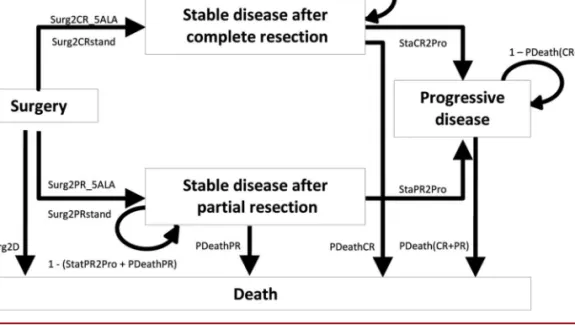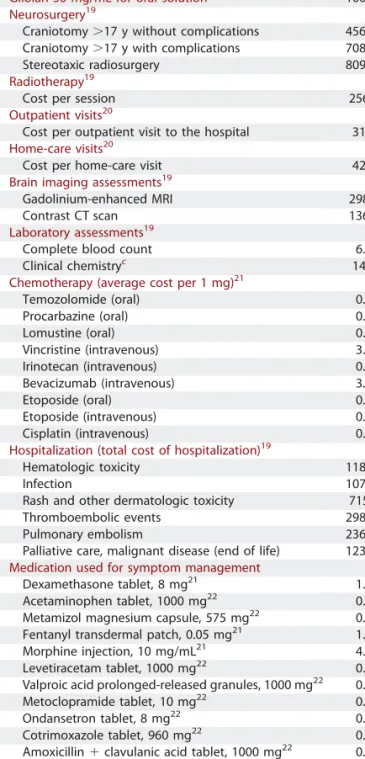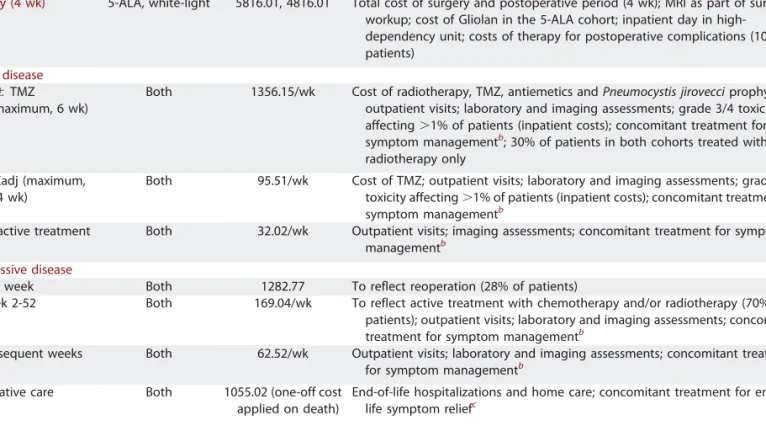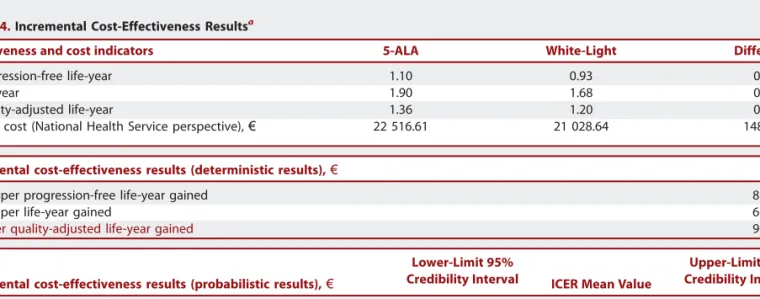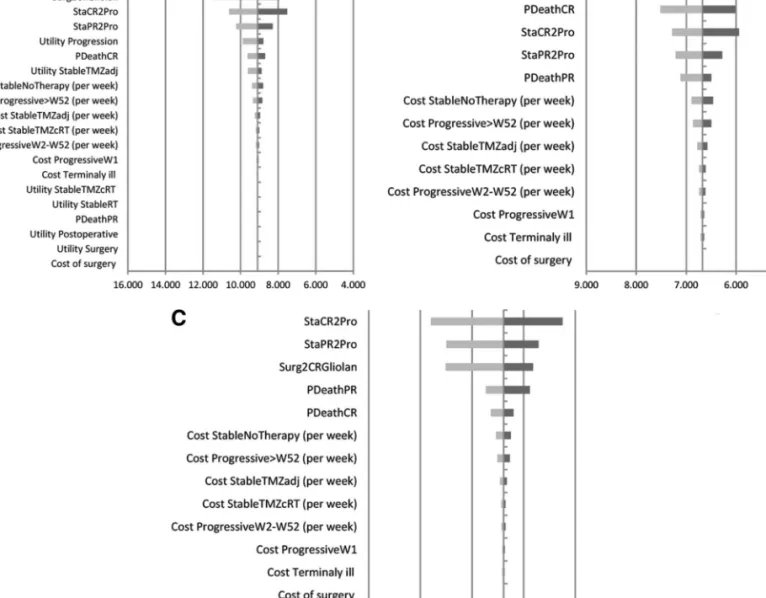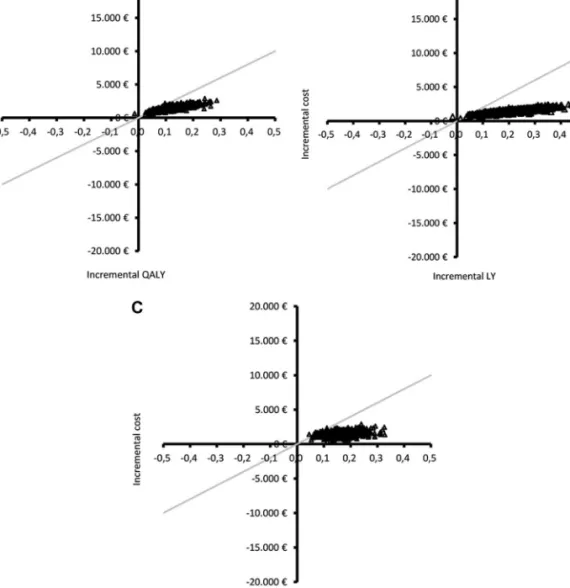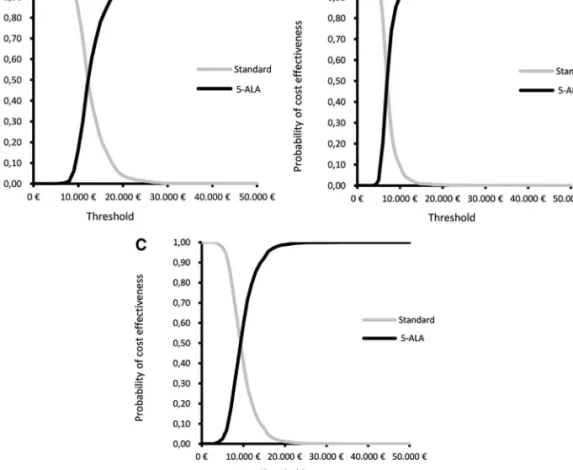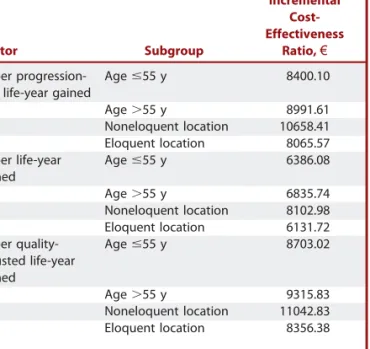A Pilot Cost-Effectiveness Analysis of Treatments
in Newly Diagnosed High-Grade Gliomas: The
Example of 5-Aminolevulinic Acid Compared With
White-Light Surgery
BACKGROUND: High-grade gliomas are aggressive, incurable tumors characterized by extensive diffuse invasion of the normal brain parenchyma. Novel therapies at best prolong survival; their costs are formidable and benefit is marginal. Economic restrictions thus require knowledge of the cost-effectiveness of treatments. Here, we show the cost-effectiveness of enhanced resections in malignant glioma surgery using a well-characterized tool for intra-operative tumor visualization, 5-aminolevulinic acid (5-ALA).
OBJECTIVE: To evaluate the cost-effectiveness of 5-ALA fluorescence-guided neuro-surgery compared with white-light neuro-surgery in adult patients with newly diagnosed high-grade glioma, adopting the perspective of the Portuguese National Health Service. METHODS: We used a Markov model (cohort simulation). Transition probabilities were estimated with the use of data from 1 randomized clinical trial and 1 noninterventional prospective study. Utility values and resource use were obtained from published litera-ture and expert opinion. Unit costs were taken from official Portuguese reimbursement lists (2012 values). The health outcomes considered were quality-adjusted years, life-years, and progression-free life-years. Extensive 1-way and probabilistic sensitivity anal-yses were performed.
RESULTS: The incremental cost-effectiveness ratios are below€10 000 in all evaluated outcomes, being around€9100 per quality-adjusted life-year gained, €6700 per life-year gained, and €8800 per progression-free life-year gained. The probability of 5-ALA fluorescence-guided surgery cost-effectiveness at a threshold of €20000 is 96.0% for quality-adjusted life-year, 99.6% for life-year, and 98.8% for progression-free life-year. CONCLUSION: 5-ALA fluorescence-guided surgery appears to be cost-effective in newly diagnosed high-grade gliomas compared with white-light surgery. This example demonstrates cost-effectiveness analyses for malignant glioma surgery to be feasible on the basis of existing data.
KEY WORDS: Cost-effectiveness, 5-Aminolevulinic acid, 5-ALA: high-grade glioma, Quality-adjusted life-years
Neurosurgery 76:552–562, 2015 DOI: 10.1227/NEU.0000000000000673 www.neurosurgery-online.com
H
igh-grade gliomas (World HealthOrga-nization grade III/IV) are the most com-mon brain tumors in adults.1In Europe, the standardized incidence rate of high-grade gliomas is 3.13/100000 inhabitants per year. The incidence is higher in adults, with a peak
.65 years of age.2 Glioblastoma is the most
common malignant tumor, accounting for 46% of all primary malignant brain tumors.3 High-grade gliomas are incurable tumors derived from glial cells characterized by extensive diffuse invasion of the normal brain parenchyma. The factors for poor prognosis are older age, glio-blastoma histology, poor performance status, and unresectable tumor.2,4
Standard treatment for newly diagnosed pa-tients comprises microsurgical resection followed Susana Esteves, PharmD,
MSc*
Marta Alves, Stat MSc‡ Marta Castel-Branco, VMD, MSc§
Walter Stummer, MD, PhD¶
*Clinical Research Unit, Instituto Portugueˆs de Oncologia de Lisboa, Lisboa, Portugal; ‡Epidemiology and Statistics Unit, Research Center of Centro Hospitalar de Lisboa Central, Hospital Dona Estefaˆnia, Lisboa, Portugal; §Microbiology Department, Escola Superior de Hotelaria e Turismo do Estoril, Estoril, Portugal; ¶Department of Neurosurgery, University of Mu¨nster, Mu¨nster, Germany
Correspondence:
Susana Esteves, PharmD, MSc, Unidade de Investigac¸a˜o Clínica, Instituto Portugueˆs de Oncologia Francisco Gentil de Lisboa, Rua Prof Lima Basto 1099-023 Lisboa, Portugal.
E-mail: sesteves@ipolisboa.min-saude.pt Received, July 31, 2014.
Accepted, December 18, 2014. Published Online, February 14, 2015. Copyright© 2015 by the
Congress of Neurological Surgeons. This is an open-access article distributed under the terms of the Creative Commons Attribution-NonCommercial-NoDerivatives 3.0 License, where it is permissible to download and share the work provided it is properly cited. The work cannot be changed in anyway or used commercially.
ABBREVIATIONS: 5-ALA, 5-aminolevulinic acid;
ICER,incremental cost-effectiveness ratio;LY,life-year;
PFLY,progression-free life-year;QALY,quality-adjusted life-year
FIGURE 1. Influence diagram. 5-ALA, 5-aminolevulinic acid; PDeathCR, probability of death for patients with complete resection (time dependent); PDeathPR, probability of death in patients with partial resection (time dependent); Surg2CR_5ALA, probability of complete resection with 5-ALA surgery; StaCR2Pro, probability of progression in patients with complete resection; Surg2CRstand, probability of complete resection with white-light surgery; StaPR2Pro, probability of progression in patients with partial resection; Surg2D, probability of death within 4 weeks of initial debulking surgery; Surg2PR_5ALA, probability of partial resection with 5-ALA surgery; Surg2PRstand, probability of partial resection with white-light surgery.
TABLE 1.Input Values and Study Parametersa
Parameter Value (95% CI) Probability Distribution Reference Transition probabilities
Surg2D 0.00375 Expert panel
Surg2CR_5ALA 0.65 b Stummer et al14
Surg2CRstand 0.36
Surg2PR_5ALA 0.35 b Stummer et al14
Surg2PRstand 0.64
StaCR2Pro 0.0197b Log normal Stummer et al13
StaPR2Pro 0.0086b
PDeathCR Time dependentc Log normal Stummer et al13
PDeathPR
Utilities
Surgery (week 1) and postoperative period (week 2-4) 0.8870 (0.845-0.929) b Rogers et al17
Stable disease, RT 0.8239 (0.425-0.995) b Garside et al16
Stable disease, RT1 TMZ 0.7426 (0.175-0.980) Stable disease, TMZadj 0.7331 (0.175-0.990) Stable disease, no active treatment 0.8872 (0.525-1.000)
Progressive disease (first week)d 0.7314 (0.125-0.995) b Garside et al16
a
CI, confidence interval; 5-ALA, 5-aminolevulinic acid; PDeathCR, probability of death for patients with complete resection (time dependent); PDeathPR, probability of death in patients with partial resection (time dependent); RT, radiotherapy; RT1 TMZ, concomitant chemoradiotherapy with temozolomide; StaCR2Pro, probability of progression in patients with complete resection; StaPR2Pro, probability of progression in patients with partial resection; Surg2CR_5ALA, probability of complete resection with 5-ALA surgery; Surg2CRstand, probability of complete resection with white-light surgery; Surg2D, probability of death within 4 weeks of initial debulking surgery; Surg2PR_5ALA, probability of partial resection with 5-ALA surgery; Surg2PRstand, probability of partial resection with white-light surgery; TMZadj, adjuvant treatment with temozolomide.
b
Exponential model.
c
Weibull model.
d
by concomitant temozolomide radiochemotherapy (the Stupp regimen) or radiotherapy for anaplastic astrocytoma and oligoden-droglioma subtypes.5,6
Extent of resection is an important prognostic factor for survival in patients undergoing initial resection,7-11 including fit elderly patients to whom aggressive surgery is not commonly offered.12 Even though 1 study has shown a positive continuous correlation between extent of resection and survival,7the majority of studies suggest that an extent of resection of at least 98% is necessary to affect survival.8-10,13Maximal safe resection for tumor debulking reduces tumor burden and optimizes the effectiveness of adjuvant radiotherapy and chemotherapy.12,13
Such multimodal therapy for malignant gliomas, however, carries a cost, and the established benefits so far are modest. In the age of increasing economic restraints imposed on the medical system, the value of therapies is more frequently being questioned. This also pertains to neurosurgical interventions. For neurosurgeons, costly adjuncts to surgery of malignant gliomas, aimed at increasing the extent of resection, are intraoperative magnetic resonance imaging and 5-aminolevulinic acid (5-ALA; Gliolan). For both adjuncts, the cost-effectiveness is difficult to fathom. With this analysis, we have attempted to demonstrate the feasibility of cost-effectiveness analyses for neurosurgical procedures, using 5-ALA as an example.
5-ALA is an orally administered prodrug used for visualization of high-grade glioma tissue during surgery, allowing a safer and more extensive tumor resection. 5-ALA is metabolized to protoporphyrin IX, a precursor of heme. High-grade glioma cells accumulate higher amounts of protoporphyrin IX than healthy tissue. Under blue excitation light (l = 400-410 nm), the tumor tissue appears red, whereas normal tissue shows no fluorescence. Clinical trial data comparing 5-ALA fluorescence-guided surgery with conventional white-light surgery showed a significant increase in the proportion of patients with complete resection and in 6-month progression-free survival.8,14These results led to the European Union approval of 5-ALA, as an orphan drug, in the indication of high-grade glioma (World Health Organization grade III/IV).
Apart from a recent Spanish cost-effectiveness study,15information on cost-effectiveness of 5-ALA fluorescence-guided neurosurgery is still scarce. Thus, we conducted a cost-effectiveness analysis of 5-ALA fluorescence-guided neurosurgery compared with white-light neuro-surgery in adult patients with newly diagnosed high-grade glioma within the context of the Portuguese National Health Service. Incremental cost-effectiveness ratios (ICERs) were estimated, con-sidering the outcomes of quality-adjusted years (QALY), life-years (LYs), and progression-free life-life-years (PFLYs).
METHODS
The target population of our study comprises adult patients with newly diagnosed high-grade glioma (World Health Organization grade III/IV) eligible for surgical resection and adjuvant therapy, treated in a Portuguese National Health Service hospital setting according to standard clinical practice. We also conducted subgroup analyses according to age (#55 vs .55 years of age) and tumor location (eloquent vs noneloquent), important
TABLE 2.Resource Use and Unit Costs (2012)a
Resource Use Unit Cost,€
Gliolan 30 mg/mL for oral solutionb 1000.00
Neurosurgery19
Craniotomy.17 y without complications 4563.66 Craniotomy.17 y with complications 7087.15 Stereotaxic radiosurgery 8097.89
Radiotherapy19
Cost per session 256.49
Outpatient visits20
Cost per outpatient visit to the hospital 31.00
Home-care visits20
Cost per home-care visit 42.00
Brain imaging assessments19
Gadolinium-enhanced MRI 298.50
Contrast CT scan 136.90
Laboratory assessments19
Complete blood count 6.40
Clinical chemistryc 14.30
Chemotherapy (average cost per 1 mg)21
Temozolomide (oral) 0.14 Procarbazine (oral) 0.12 Lomustine (oral) 0.49 Vincristine (intravenous) 3.13 Irinotecan (intravenous) 0.17 Bevacizumab (intravenous) 3.35 Etoposide (oral) 0.18 Etoposide (intravenous) 0.04 Cisplatin (intravenous) 0.13
Hospitalization (total cost of hospitalization)19
Hematologic toxicity 1180.63
Infection 1072.56
Rash and other dermatologic toxicity 715.28 Thromboembolic events 2985.97
Pulmonary embolism 2369.89
Palliative care, malignant disease (end of life) 1230.23
Medication used for symptom management
Dexamethasone tablet, 8 mg21 1.50
Acetaminophen tablet, 1000 mg22 0.03 Metamizol magnesium capsule, 575 mg22 0.05 Fentanyl transdermal patch, 0.05 mg21 1.72 Morphine injection, 10 mg/mL21 4.06 Levetiracetam tablet, 1000 mg22 0.82 Valproic acid prolonged-released granules, 1000 mg22 0.55 Metoclopramide tablet, 10 mg22 0.02 Ondansetron tablet, 8 mg22 0.83 Cotrimoxazole tablet, 960 mg22 0.15 Amoxicillin1 clavulanic acid tablet, 1000 mg22 0.32
Azithromycin tablet, 500 mg22 1.35
Enoxaparin, 40 mg/0.4 mL22 3.17
a
CT, computed tomography; MRI, magnetic resonance imaging.
b
medac Portugal.
c
Clinical chemistry: alanine aminotransferase, aspartate aminotransferase, g-glutamyltransferase, urea, glycemia, creatinine, C-reactive protein, and ionogram.
prognostic factors. The study perspective was the Portuguese Health Care System. Only direct medical care costs were considered, including the cost of the intervention itself and follow-up medical care until death.
We constructed a Markov model based on the model described by Garside et al16and Rogers et al.17This modeling approach allows simulation of the natural history of disease, deterioration of the patient’s clinical condition, and subsequent fluctuations in health-related quality of life.
The model was run as a cohort simulation of 1000 people with 1 treatment cohort (5-ALA fluorescence-guided surgery) and 1 comparator cohort (white-light surgery), both followed by adjuvant radiochemother-apy with temozolomide or radiotherradiochemother-apy. A cycle length of 1 week was considered. The model was run until the death of all patients in both cohorts (time horizon, 411 weeks/7.9 years), thus accounting for lifetime costs and clinical benefits. Health outcomes were evaluated in QALYs, LYs, and PFLYs. A discount rate of 5% was applied to both health outcomes and costs, as recommended by the Portuguese guidelines for pharmacoeconomic analysis.18
Model Structure
The model comprises 5 health states: surgery, stable disease with complete resection, stable disease with partial resection, progressive disease, and death (Figure 1). The initial state, surgery, comprises surgery and postoperative recovery. All patients remain in this state for
a fixed period of 4 weeks; they leave only if they die. After this period, all patients alive move to one of the stable disease states (with or without complete resection). Both stable disease states comprise 3 sequential substates, namely radiotherapy with or without concomitant temozolo-mide (maximum, 6 weeks), adjuvant temozolotemozolo-mide (maximum, 24 weeks), and no treatment. Patients remain in stable disease states until they either die or have disease progression. The progressive disease state was modeled as a sequence of 120 substates to simulate subsequent treatments and the patient’s clinical deterioration. Thus, several periods were considered: week 1, during which a proportion of patients are submitted to second standard white-light surgery in both cohorts (5-ALA not considered in reoperation); weeks 2 to 52, the period that accounts for active treatment such as chemotherapy and radiotherapy in a proportion of patients; and weeks $53, the period accounting for supportive care. In the progressive disease state, the patient’s clinical deterioration was modeled assuming a 0.5% decrement of utility value per week/cycle. The death state includes all causes of deaths.
Input Values and Study Parameters
Input parameters comprising transition probabilities, health state utilities, and their respective sources are summarized in Table 1. Utility values were taken from the literature. The same utility values were considered for complete resection and partial resection stable disease states.
TABLE 3.Summary of Costs Used in the Economic Model (2012)a
Description Cohort Cost,€ Details
Surgery (4 wk) 5-ALA, white-light 5816.01, 4816.01 Total cost of surgery and postoperative period (4 wk); MRI as part of surgical workup; cost of Gliolan in the 5-ALA cohort; inpatient day in high-dependency unit; costs of therapy for postoperative complications (10% of patients)
Stable disease
RT6 TMZ (maximum, 6 wk)
Both 1356.15/wk Cost of radiotherapy, TMZ, antiemetics and Pneumocystis jirovecci prophylaxis; outpatient visits; laboratory and imaging assessments; grade 3/4 toxicity affecting.1% of patients (inpatient costs); concomitant treatment for symptom managementb; 30% of patients in both cohorts treated with
radiotherapy only TMZadj (maximum,
24 wk)
Both 95.51/wk Cost of TMZ; outpatient visits; laboratory and imaging assessments; grade 3/4 toxicity affecting.1% of patients (inpatient costs); concomitant treatment for symptom managementb
No active treatment Both 32.02/wk Outpatient visits; imaging assessments; concomitant treatment for symptom managementb
Progressive disease
First week Both 1282.77 To reflect reoperation (28% of patients)
Week 2-52 Both 169.04/wk To reflect active treatment with chemotherapy and/or radiotherapy (70% of patients); outpatient visits; laboratory and imaging assessments; concomitant treatment for symptom managementb
Subsequent weeks Both 62.52/wk Outpatient visits; laboratory and imaging assessments; concomitant treatment for symptom managementb
Palliative care Both 1055.02 (one-off cost applied on death)
End-of-life hospitalizations and home care; concomitant treatment for end-of-life symptom reliefc
a
5-ALA, 5-aminolevulinic acid; MRI, magnetic resonance imaging; RT6 TMZ, radiotherapy with or without concomitant temozolomide; TMZ, temozolomide; TMZadj, adjuvant temozolomide.
b
Antiepileptics, corticosteroids, antiemetics, analgesics, and anticoagulation therapy.
c
An expert panel (composed of 1 radio-oncologist, 2 neuro-oncologists, and 1 neurosurgeon) validated the Portuguese clinical practice and resource use from diagnosis until death.
The panel defined the fixed transition probability from surgery to death. Transition probabilities from surgery to stable disease states (with or without complete resection) were taken from Stummer et al14 randomized clinical trial, which included 270 newly diagnosed patients with a median age of approximately 59 years (range, 23-73 years) and World Health Organization grade IV glioma in 97%. In this trial, 65% of patients (90 of 139) treated with 5-ALA and 36% of patients (47 of 131) submitted to white-light surgery had a complete resection of contrast-enhancing tumor. Only a small proportion of patients in this trial received adjuvant chemotherapy. Because the current standard practice comprises adjuvant radiochemotherapy with temozolomide (the Stupp regimen), the transition probabilities from stable disease states to death and progressive disease were based on data from a multicenter, prospective, noninterventional cohort study.13 This study was designed to test the effect of extensive
cytoreductive surgery when combined with temozolomide radio-chemotherapy followed by adjuvant temozolomide on progression-free survival and overall survival. It included 143 patients with newly diagnosed glioblastoma eligible for surgery with a median age of 59.5 years (range, 21-81 years).13
Transition probabilities from stable disease states to death and progressive disease states were estimated by use of parametric survival models fitted to individual patient data from this noninterventional study. Transition probabilities to death were estimated from a Weibull survival model with a shape parameter.1, taking extent of resection as a covariate (complete vs partial). Thus, we considered a time-dependent probability of death that increases with time.
An exponential model, also including extent of resection as a covariate, was used to estimate transition probabilities from stable disease states to progressive disease. Goodness of fit of parametric models was evaluated by
comparing with Kaplan-Meier estimates (survival curves and median survival estimates) and checking the proportionality of cumulative hazard risk function.
The type and quantification of resources used were derived from the expert panel. Unit costs were taken from official Portuguese reimburse-ment lists (2012 values). Table 2 summarizes the resources and respective unit costs considered in the model. Table 3 summarizes the costs associated with each Markov state. Palliative care costs were attached to the transition from progressive disease to death.
Five-ALA toxicity was not considered because clinical trial data did not show any significant difference between fluorescence-guided and white-light neurosurgery in the frequency of severe adverse events, neurological impairments, or laboratory measurements with the exception of a transient increase, without major clinical impact, of g-glutamyl transpeptidase and alanine and aspartate transaminases.14
Grade $3 toxicities of adjuvant treatment affecting.1% of patients were included because of the potential impact on resource use. These comprised hematologic toxicity, severe infection, pulmonary embo-lism, and deep vein thrombosis5(validated by the expert panel). Sensitivity Analysis
Extensive 1-way and probabilistic sensitivity analyses were performed. We also evaluated the robustness of results to different discount rates (0%, 3%, 5%, and 7%).
One-way sensitivity analysis comprised the transition probabilities, costs of each health state, and utility values. Variation limits used were the 95% confidence interval limits for the proportion of complete resections and utilities and a 20% variation for all other parameters.
Probability distributions used in probabilistic analysis were b distri-bution for transition probabilities and utilities, g distridistri-bution for costs, and log normal for the parameters of survival models (Table 1). Simultaneous multivariate stochastic analysis was performed running 1000 Monte Carlo simulations.
TABLE 4.Incremental Cost-Effectiveness Resultsa
Effectiveness and cost indicators 5-ALA White-Light Difference
Progression-free life-year 1.10 0.93 0.17
Life-year 1.90 1.68 0.22
Quality-adjusted life-year 1.36 1.20 0.16
Total cost (National Health Service perspective),€ 22 516.61 21 028.64 1487.97
Incremental cost-effectiveness results (deterministic results),€ ICER
Cost per progression-free life-year gained 8780.84
Cost per life-year gained 6675.52
Cost per quality-adjusted life-year gained 9097.47
Incremental cost-effectiveness results (probabilistic results),€
Lower-Limit 95%
Credibility Interval ICER Mean Value
Upper-Limit 95% Credibility Interval
Cost per progression-free life-year gained 5025.15 9841.86 17 578.34
Cost per life-year gained 4995.59 7385.54 12 631.37
Cost per quality-adjusted life-year gained 8282.90 12 932.92 21 314.63
a
An alternative scenario analysis was also conducted by use of the Kaplan-Meier estimates with survival extrapolation with parametric survival models from the point where insufficient data were available.
RESULTS
Base-Case Analysis
Base-case cost-effectiveness results are displayed in Table 4. The mean effectiveness results of 5-ALA surgery projected by the model are 1.36 QALYs, 1.10 PFLYs, and a life expectancy of 1.90 years.
These represent an increase of 0.16 QALY, 0.22 LY, and 0.17 PFLY over white-light surgery. The results obtained show a beneficial effect of 5-ALA in all evaluated health effects with an incremental cost of approximately€1500 for National Health Service.
ICERs are below€10000 in all evaluated outcomes (Table 4). Uncertainty Analysis
One-way sensitivity analyses are displayed in tornado diagrams (Figure 2A-2C). The results concerning incremental cost per additional QALY (Figure 2A) show that the model is
FIGURE 2. Tornado diagrams of 1-way sensitivity analyses concerning incremental cost-effectiveness ratios, National Health Service perspective.A, incremental cost per quality-adjusted life-year gained (in euros).B, incremental cost per life-year gained (in euros).C, incremental cost per progression-free life-year gained (in euros). PDeathCR, probability of death for patients with complete resection; PDeathPR, probability of death in patients with partial resection; Progressive.W52, progressive disease state after week 52; ProgressiveW1, first week in progressive disease state; ProgressiveW2-W52, progressive disease state from week 2 to 52; StableNoTherapy, stable disease after partial or complete resection without active treatment; StableRT, stable disease after partial or complete resection receiving radiotherapy; StableTMZadj, stable disease after partial or complete resection receiving adjuvant temozolomide treatment; StableTMZcRT, stable disease after partial or complete resection receiving concomitant radiotherapy and temozolomide; StaCR2Pro, probability of progression in patients with complete resection; StaPR2Pro, probability of progression in patients with partial resection; Surg2CRGliolan, probability of complete resection with 5-aminolevulinic acid surgery.
particularly sensitive to changes in the utility value attributed to the stable disease with no therapy substate. The other 3 most influential variables are the proportion of patients with complete resection in the 5-ALA cohort and the 2 transition probabilities from stable disease states (with complete and partial resection) to progressive disease. In all plausible variations tested, incremental cost per additional QALY is below€14000 (Figure 2A).
The parameters with the greatest impact in incremental cost per additional LY (Figure 2B) and per additional PFLY (Figure 2C) are the proportion of patients with complete resection in the
5-ALA cohort, the probabilities of death in patients with complete and partial remission, and the probability of progression from stable disease states. It should be noted that all plausible variations tested yield incremental costs per LY gained and incremental costs per PFLY gained below €9000 and €12000, respectively (Figure 2B and 2C).
Results are robust to variation in discount rates (0%, 3%, 5%, and 7%), ranging from€8250 to €10127 for incremental cost per additional QALY, €5963 to €7473 for incremental cost per additional LY, and €8174 to €9678 for incremental cost per additional PFLY.
FIGURE 3. Scatter diagram of Monte Carlo simulation results in the cost-effectiveness plane, National Health Service per-spective.A, incremental cost per quality-adjusted life-year (QALY) gained.B, incremental cost per life-year (LY) gained.C, incremental cost per progression-free life-year (PFLY) gained. The gray line represents a willingness-to-pay threshold of€20000 per additional QALY, LY, or PFLY. Results are located in the upper-right quadrant, reflecting a beneficial effect of 5-aminolevulinic acid fluorescence-guided surgery in all health effects evaluated but at a higher cost. In the 3 scatterplots, the majority of the simulation results are located below the threshold line, indicating a very high probability of incremental cost-effectiveness ratio being inferior to€20000 for all health effects evaluated.
Probabilistic analysis results are given in Table 4. These show that, in 95% of cases, incremental cost per LY gained and incremental cost per PFLY gained are inferior to€13000 and €18000, respectively. When the ICER for QALY is considered, the upper limit of the 95% credibility interval increases to €21000, which might be explained by the poor underlying quality of life usually reported in these patients.
In Figure 3A through 3C, the ICER results of 1000 Monte Carlo simulations for the 3 health outcomes are graphically presented on the cost-effectiveness plane. It can be clearly seen that the overwhelming majority of simulation results are located in the upper-right quadrant below the willingness-to-pay threshold of €20000. This reflects a beneficial effect of 5-ALA surgery compared with white-light surgery and suggests a high probability of an additional cost below €20000 in all health effects evaluated. This is further confirmed by the cost-effectiveness acceptability curves (Figure 4A-4C), which show the probability of considering 5-ALA cost-effective at different willingness-to-pay thresholds, given joint parameter uncer-tainty. The probability of 5-ALA cost-effectiveness at a threshold
of€20000 is 99.6% for LY, 98.8% for PFLY, and 96.0% for QALY.
ICER point estimates obtained in alternative scenario analysis using Kaplan-Meier estimates are €8868.92 per PFLY gained, €6820.88 per LY gained, and €9401.99 per additional QALY. These results are similar to those obtained in the base-case analyses with parametric survival models (Table 4).
Subgroup Analyses
Table 5 presents the ICER point estimates obtained in subgroup analyses. These results are similar to those of the base case but suggest that 5-ALA is more cost-effective in patients,56 years of age and with eloquent tumor location for all end points.
DISCUSSION
We performed a cost-effectiveness analysis of 5-ALA surgery compared with white-light surgery, current standard practice in Portuguese hospitals, in newly diagnosed adult patients with high-grade glioma.
FIGURE 4.Cost-effectiveness acceptability curves, National Health Service perspective.A, incremental cost-per quality adjusted life-year gained. B, incremental cost per life-year gained. C, incremental cost per progression-free life-year gained. The acceptability curves represent, for several willingness-to-pay threshold values ranging from€0 to €50000, the probability that the incremental cost-effectiveness ratio is below the considered threshold value. 5-ALA, 5-aminolevulinic acid.
A similar analysis might be performed for other adjuncts to glioma surgery, provided that the effects on resection are well characterized, such as for intraoperative magnetic resonance imaging.23
The study perspective adopted was the Portuguese National Health Service. ICERs for the 3 health outcomes evaluated (QALY, LY, and PFLY) are between€6600 and €9300. These values are well below the willingness-to-pay threshold of £20000 considered by National Institute of Clinical Excellence.24 Extensive 1-way and probabilistic sensitivity analyses showed robustness of the results to uncertainties in model parameter estimates. Although subgroup analysis results are similar to the results of the base case, they suggest a higher cost-effectiveness of 5-ALA in patients,56 years of age and with eloquent tumor location.
Limitations
One important assumption of our Markov model is the separation of stable disease states on the basis of complete and partial resection. Although this may be regarded as an over-simplification, it is grounded by several studies showing that complete resection is an independent prognostic factor for overall survival.8-10,13 Another assumption is the time-dependent, instead of state-dependent, risk of death, which appears to be a counterintuitive approach because probability of death is expected to be higher in progressive states. However, transition to death was based on a Weibull model in which the probability of death increases with time as more patients also experience disease progression. A third assumption is that all patients receive surgery soon after diagnosis and postoperative treatment shortly after surgery. The potential impact of longer waiting times was not considered.
Our model was based on clinical data from 2 studies, 1 head-to-head randomized clinical trial comparing 5-ALA surgery with white-light surgery14and 1 noninterventional prospective cohort study designed to test the effect of extensive cytoreductive surgery combined with the Stupp regimen.5,13 As a consequence, our study has a limitation related to data availability that renders model estimations dependent on any bias in these studies such as the underrepresentation of grade III gliomas. In addition, there is some degree of uncertainty in survival estimation resulting from small sample size and limited follow-up (median, 24 months). Nevertheless, the goodness of fit of the parametric survival models was acceptable for both the Weibull and exponential models. Finally, the probabilistic sensitivity analysis and the Kaplan-Meyer alternative scenario showed that results are robust to the variability of the parameters of the survival models.
It is likely, however, that the present analysis underestimates the cost-effectiveness of 5-ALA. The assumptions for the incremental rates of resections when 5-ALA is used were taken from the approval study published in 200614 and thus were based on the first patients operated on. To date, the experience with 5-ALA has increased, and the use of neurophysiological monitoring has become much more common for high-grade gliomas. Published resection rates are now between 80% and 96%.25-27
To the best of our knowledge, the most relevant clinical studies published to date that evaluated the impact of extent of resection in survival did not include adjuvant radiochemotherapy with temozo-lomide as part of treatment.7-9,28 The observational, retrospective study of the effectiveness of 5-ALA in malignant glioma in Spain (the VISIONA study)29 included this therapy but reported only results concerning complete resection rate and 6-month progression-free survival. For these reasons, it is not possible to make direct comparisons of survival outcomes between VISIONA and the noninterventional study used in our model.
Another aspect to be considered is the use of utility values obtained from a panel of British respondents, which do not ne-cessarily match the preferences of the Portuguese population.
The pharmacoeconomic study published by Slof et al,15based on data collected in the VISIONA observational study,29 also compared 5-ALA surgery with white-light surgery in newly diagnosed adult patients undergoing surgery for malignant glioma. Despite comparing the gains in QALYs between treatment groups, the Slof et al15 study included only the incremental costs associated with the 5-ALA intervention, which are incurred in the beginning of the analysis period. This is an important difference from our model; we considered not only the costs of initial surgery but also the costs incurred after surgery, during the lifetime of all patients. Interestingly, the results of incremental cost per additional QALY are similar in both studies. This may be explained in part by the minor gain in QALYs considered in the Slof et al15study, together with an underestimation of the incremental costs.
Our model did not evaluate the potential effect of 5-ALA surgery at recurrence. Given that the extent of resection has
TABLE 5.Subgroup Analysis
Indicator Subgroup
Incremental Cost-Effectiveness
Ratio,€
Cost per progression-free life-year gained
Age #55 y 8400.10
Age.55 y 8991.61
Noneloquent location 10658.41 Eloquent location 8065.57 Cost per life-year
gained
Age #55 y 6386.08
Age.55 y 6835.74
Noneloquent location 8102.98 Eloquent location 6131.72 Cost per
quality-adjusted life-year gained Age #55 y 8703.02 Age.55 y 9315.83 Noneloquent location 11042.83 Eloquent location 8356.38
been shown to be an important prognostic factor not only in initial resection but also at recurrence,30this question should be addressed in future studies. In addition, future studies should also include subgroup analysis comprising important prognostic factors such as the methylation status of the O6-methylguanine-DNA methyltransferase promoter. Given the synergistic effect between complete resection and adjuvant radiochemotherapy particularly seen in patients with O6-methylguanine-DNA methyltransferase promoter methyla-tion,13 a higher cost-effectiveness of 5-ALA may be antici-pated in this subgroup.
Finally, future studies should also consider a societal perspec-tive, taking into account productivity losses, family costs, and other indirect and direct nonmedical costs incurred by the patient.
CONCLUSION
Our analysis suggests that 5-ALA fluorescence-guided surgery is cost-effective in newly diagnosed high-grade gliomas compared with white-light surgery.
Disclosures
Support for this study was provided by medac GmbH, Wedel, Germany. Dr Esteves, M. Alves, and Dr Castel-Branco received a grant from medac GmbH, Wedel, Germany, in relation to this study. Dr Stummer has received lecturing fees from medac. Otherwise, the authors have no personal, financial, or institutional interest in any of the drugs, materials, or devices described in this article.
REFERENCES
1. Merrell RT, Wen PY. Management of Gliomas 2010. Available at: http://www. clinicaloptions.com/inPractice/Oncology/Brain_and_CNS_Malignancies/ch35_Brain-Gliomas/Pages/Page%201.aspx. Accessed September 18, 2011.
2. Crocetti E, Trama A, Stiller C, et al. Epidemiology of glial and non-glial brain tumors in Europe. Eur J Cancer. 2012;48(10):1532-1542.
3. Ostrom QT, Gittleman H, Liao P, et al. CBTRUS Statistical report: primary brain and central nervous system tumors diagnosed in the United States in 2007-2011. Neuro Oncol. 2014;16(suppl 4):iv1-iv63.
4. Curran WJ Jr, Scott CB, Horton J, et al. Recursive partitioning analysis of prognostic factors in three Radiation Therapy Oncology Group malignant glioma trials. J Natl Cancer Inst. 1993;85(9):704-710.
5. Stupp R, Mason WP, van den Bent MJ, et al. Radiotherapy plus concomitant and adjuvant temozolomide for glioblastoma. N Engl J Med. 2005;352(10): 987-996.
6. Stupp R, Tonn JC, Brada M, Pentheroudakis G; ESMO Guidelines Working Group. High-grade malignant glioma: ESMO clinical practice guidelines for diagnosis, treatment and follow-up. Ann Oncol. 2010;21(suppl 5): v190-v193.
7. Sanai N, Polley MY, McDermott MW, Parsa AT, Berger MS. An extent of resection threshold for newly diagnosed glioblastomas. J Neurosurg. 2011;115(1):3-8. 8. Stummer W, Reulen HJ, Meinel T, et al. Extent of resection and survival in
glioblastoma multiforme: identification of and adjustment for bias. Neurosurgery. 2008;62(3):564-576.
9. Lacroix M, Abi-Said D, Fourney DR, et al. A multivariate analysis of 416 patients with glioblastoma multiforme: prognosis, extent of resection, and survival. J Neurosurg. 2001;95(2):190-198.
10. Kreth FW, Thon N, Simon M, et al. Gross total but not incomplete resection of glioblastoma prolongs survival in the era of radiochemotherapy. Ann Oncol. 2013; 24(12):3117-3123.
11. Albert FK, Forsting M, Sartor K, Adams HP, Kunze S. Early postoperative magnetic resonance imaging after resection of malignant glioma: objective
evaluation of residual tumor and its influence on regrowth and prognosis. Neurosurgery. 1994;34(1):45-60.
12. Chaichana KL, Chaichana KK, Olivi A, et al. Surgical outcomes for older patients with glioblastoma multiforme: preoperative factors associated with decreased survival: clinical article. J Neurosurg. 2011;114(3):587-594.
13. Stummer W, Meinel T, Ewelt C, et al. Prospective cohort study of radiotherapy with concomitant and adjuvant temozolomide chemotherapy for glioblastoma patients with no or minimal residual enhancing tumor load after surgery. J Neurooncol. 2012;108(1):89-97.
14. Stummer W, Pichlmeier U, Meinel T, Wiestler OD, Zanella F, Reulen HJ. Fluorescence-guided surgery with 5-aminolevulinic acid for resection of malignant glioma: a randomised controlled multicentre phase III trial. Lancet Oncol. 2006;7 (5):392-401.
15. Slof J, Díez Valle R, Galván J. Cost-effectiveness of 5-aminolevulinic acid-induced fluorescence in malignant glioma surgery. Neurologia. 2014;pii:S0213-4853(13) 00286-7. doi: 10.1016/j.nrl.2013.11.002. Available at: http://zl.elsevier.es/es/ revista/-295/linkresolver/analisis-coste-efectividad-cirugia-del-glioma-S02134853% 2813%29002867. Epub 2014 Jan 24. Accessed April 2014.
16. Garside R, Pitt M, Anderson R, et al. The effectiveness and cost-effectiveness of carmustine implants and temozolomide for the treatment of newly diagnosed high-grade glioma: a systematic review and economic evaluation. Health Technol Assess. 2007;11(45):iii-iv, ix-221.
17. Rogers G, Garside R, Mealing S, et al. Carmustine implants for the treatment of newly diagnosed high-grade gliomas. Pharmacoeconomics. 2008;26(1):33-44. 18. Silva EA, Gouveia Pinto C, Sampaio C, et al. Orientações Metodológicas para Estudos
de Avaliação Económica de Medicamentos. INFARMED; 1998. Portugal. Available at: http://www.ispor.org/peguidelines/source/orien_metodologicas_eaem.pdf. Accessed October 29, 2012.
19. Ministério da Saúde (2009b), Diário da República, N°147/2009, 1° suplemento série I de 2009-07-31 - Portaria N° 839-A/2009, de 31 de Julho de 2009. Available at: https://dre.pt/application/file/242090. Accessed October 29, 2012.
20. Ministério da Saúde (2009a), Diário da República, N°21/2009, série I de 2009-01-30 - Portaria N° 132/2009, de 30 de Janeiro de 2009. Available at: https://dre.pt/application/file/601655. Accessed October 29, 2012.
21. ACSS. Portuguese drug formulary for NHS hospitals. Available at: www.catalogo. min-saude.pt/caps/publico/pub_consulta.asp. Accessed October 29, 2012. 22. INFARMED. Portuguese National Authority of Medicines and Health Products
drug formulary. Available at: www.infarmed.pt/genericos/pesquisamg/pesquisaMG. php. Accessed October 29, 2012.
23. Senft C, Bink A, Franz K, Vatter H, Gasser T, Seifert V. Intraoperative MRI guidance and extent of resection in glioma surgery: a randomised, controlled trial. Lancet Oncol. 2011;12(11):997-1003.
24. NICE. Guide to the Methods of Technology Appraisal. 2004. (Ref N0515) paragraphs 6.2.6.10—11. National Institute for Clinical Excellence. London. 2004. ISBN 1-84257-595-3.
25. Schucht P, Beck J, Abu-Isa J, et al. Gross total resection rates in contemporary glioblastoma surgery: results of an institutional protocol combining 5-aminolevulinic acid intraoperative fluorescence imaging and brain mapping. Neurosurgery. 2012; 71(5):927-935.
26. Díez Valle R, Tejada Solis S, Idoate Gastearena MA, García de Eulate R, Domínguez Echávarri P, AristuMendiroz J. Surgery guided by 5-aminolevulinic fluorescence in glioblastoma: volumetric analysis of extent of resection in single-center experience. J Neurooncol. 2011;102(1):105-113.
27. Della Puppa A, De Pellegrin S, d’Avella E, et al. 5-Aminolevulinic acid (5-ALA) fluorescence guided surgery of high-grade gliomas in eloquent areas assisted by functional mapping: our experience and review of the literature. Acta Neurochir (Wien). 2013;155(6):965-972.
28. Laws ER, Parney IF, Huang W, et al; Glioma Outcomes Investigators. Survival following surgery and prognostic factors for recently diagnosed malignant glioma: data from the Glioma Outcomes Project. J Neurosurg. 2003;99(3): 467-473.
29. Díez Valle R, Slof J, Galván J, Arza C, Romariz C, Vidal C. Observational, retrospective study of the effectiveness of 5-aminolevulinic acid in malignant glioma surgery in Spain (the VISIONA study) Neurologia. 2014;29(3): 131-138.
30. Bloch O, Han SJ, Cha S, et al. Impact of extent of resection for recurrent glioblastoma on overall survival: clinical article. J Neurosurg. 2012;117(6):1032-1038.
Acknowledgments
We thank the members of the expert panel: Francisco Mascarenhas, MD, Luísa Albuquerque, MD, Miguel Casimiro, MD, and Teresa Pimentel, MD. We gratefully acknowledge Sofia Ferreira, PharmD (medac Portugal) and Stefanie Tille (medac GmbH, Wedel, Germany) for all support. We also thank Josefine Glatte and Floriano Rodrigues, Dr.rer.nat., for their helpful comments on this report (medac GmbH, Wedel, Germany).
COMMENTS
P
roperly performed cost-effectiveness studies are essential to societies that seek to pool and intelligently use limited healthcare resources. Modeling studies such as this one are central to that process; however, the results of such studies are only as reliable as the hard data and assumptions from which a given model is created. Here, each of the 2 critical inputs (1, that the rate of achieving gross total resection is significantly greater when using 5-aminolevulinic acid [5-ALA] than when performing stan-dard white-light resection; and 2, that radiographic gross total resection increases longevity without increasing neurological complications) is based either on just 1 study (item 1), or studies that are contradicted by others (item 2). Even if both of these inputs are true, the model demon-strates that use of 5-ALA yields a modest increase in quality survival of 0.16 quality-adjusted life-year, or 8.3 weeks. For an intervention yielding such a modest extension of life to be cost-effective, it must be quite inexpensive relative to the overall cost of therapy, which at€1500, 5-ALA is. To me, the question is not whether 5-ALA–guided glioblastoma resection is cost-effective but whether it truly confers a significant increase in quality survival. If it does, the modest additional cost of using it will not be an issue. Conversely, given the modest quality-adjusted life-year gains predicted by the model, a prospective randomized trial comparing real-world outcomes in patients operated on with and without 5-ALA guidance will require a very large cohort to detect a statistically significant extension of meaningful survival. Such a study would be quite expensive to conduct and so seems impractical.Ron L. Alterman Boston, Massachusetts
M
odeling techniques as used in this study are rapidly becoming useful for providing insight into various disease processes and assessments of treatment. Their use here may be indicative and at this stage in the appraisal of use of the 5-aminolevulinic acid (5-ALA) technique is inter-esting, although the article is based largely on glioblastoma 5-ALA studies that show optimistic data. Caution is necessary in that modeling can bewhatever the authors wish it to be, and frequently there is a great deal of bias in this sort of work. However, as long as various input parameters are included to demonstrate various outcomes, the reader will benefit from such information that may reflect scenarios of surgical improvement, effectiveness, and economic advantage. The studies showing the benefit of 5-ALA over standard white-light operative microscopy should be balanced with data taken from other studies and then used as part of the model. Such modeling should be updated as new data or parameters become available for input or mathematical techniques are refined.
I suspect the authors are onto something and believe that, as they do, there are other ways that might be better at identifying the regions of tumor cells than conventional magnetic resonance imaging, which at-tempts to assess the tumor margins on the basis of contrast enhancement or anatomic boundaries, and that this obviously influences survival and economics. The point is, How much does the 5-ALA method influence medical economics and survival? 5-ALA and other fluorescent labeling techniques, combined with new imaging technology, may better iden-tify the tumor cellular mass and individual migrating cells in vivo, which must be the goal for more complete resection. Similarly, other imaging technologies such as 1H-magnetic resonance spectroscopic imaging have been able to show the metabolic and chemical changes that precede structural change or progression in glioblastoma, but unfortunately, such technology has not taken hold or been subjected to rigorous cost-effective analysis, although in certain neurosurgical centers it has been of advantageous use.
The point is that we can do better than basing resections on imaging technology that we believe indicates or reflects the tumor mass or margins when it does not. Although the actual gains noted in this study for survival are minimal, perhaps they are a step forward in accom-plishing better glioblastoma resection, which, along with the topic of survival, has been the subject of the same discussions since the 1920s and with which we have had little success in real, meaningful improvement in survival or quality of life. If we significantly improve survival, then there should be an economic benefit, provided that the benefit is also better quality of life, not just more tumor resected from the brain. This study seems to indicate an economic benefit for the Portuguese National Health System and, if representative, should have greater impact in a health system that entails greater patient care expenses. However, the limited nature of this study will need to be further explored with addi-tional modeling, but crucial answers to these issues will require studies of actual patient costs and assessments of their quality of life.
Mark C. Preul Phoenix, Arizona
